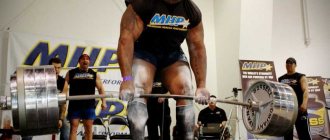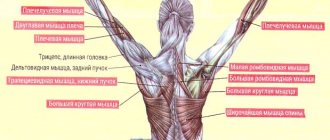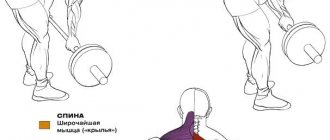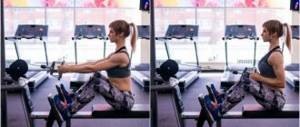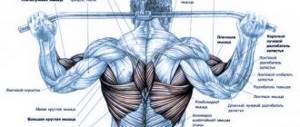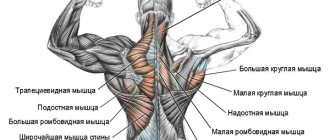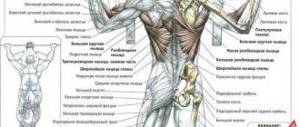Author: Timko Ilya - the ruler of the entire site and fitness trainer | more details >> Rod. 1984 Trained since 1999 Trained since 2007. Author and creator of the site tvoytrener.com. CCM in powerlifting. Champion of Russia and South Russia according to AWPC. Champion of the Krasnodar region according to IPF. 1st category in weightlifting. 2-time winner of the Krasnodar Territory championship in t/a. Author of more than 700 articles on fitness and amateur athletics. Author and co-author of 5 books.
Place in the ranking of authors:
out of competition
(become an author) Date: 2012-05-29 Views: 284,208 Rating: 4.9
| All articles by the author >> | Medals articles >> |
Articles are loading...
| Article medals: | more than 100 thousand views |
Why medals are given to articles:
| Bronze medal: | |
| 1. The article is in the TOP 100 2. The article has more than 3. The article has more than 100 | |
| Silver medal: | |
| 1. The article is in the TOP 50 2. The article has more than 3. The article has more than 500 | |
| Gold medal: | |
| 1. The article is in the TOP 10 2. The article has more than 1 3. The article has more than 1,000 | |
Main muscles - latissimus Additional - biceps and teres major Difficulty - medium
Load by muscle group
The load is indicated on a 10-point scale (the total load is summed up)
| Biceps | 7 (high) |
| Latissimus muscles | 7 (high) |
| Forearms | 4 (average) |
| Upper back | 3 (average) |
| Total load/exercise type | 21 (medium) / basic local |
Upper block rows form a wide back
The lat pulldown is one of the basic exercises for developing the latissimus dorsi muscles.
This exercise is identical to pull-ups on a horizontal bar, but, unlike regular pull-ups, the body remains in place, and the bar moves along a certain path.
It is advisable to leave rowing in the block until the end of the workout precisely in order to finally “finish off” the back muscles.
So, let's begin a detailed look at this exercise, starting with an overview of the muscle groups that are involved in performing the movements.
The upper block pull has an advantage over the horizontal bar in terms of accessibility and the ability to adjust the weight. For example, a beginner will not be able to do three sets of pull-ups on a horizontal bar for 8-12 repetitions.
Therefore, at the initial stage, the lat pulldown will be an ideal exercise for increasing strength and building muscles. After some time, there will be no difficulties with pull-ups.
For girls, the block pull is an excellent exercise that allows you to make your back muscles more prominent and create a beautiful back contour.
What muscles work
The load varies depending on the choice of grip, but in any of these exercises the following muscles are worked: latissimus, posterior deltoids, trapezius, rhomboids, biceps and forearms.
Execution options
First of all, the exercise is characterized by grip. According to the position of the hands on the handle, it can wash:
- wide,
- narrow;
- parallel.
In this case, the handle can be held with your palms facing you or away from you.
Correct technique
Wide grip lat row
Next, you should sit down so that the bolster for supporting your legs rests firmly on your hips and does not allow upward movements of the body. In this case, it is necessary to maintain the position of the body so that the natural curve in the lower back is preserved.
After this, with a powerful and smooth movement, pull the bar to your upper chest by abducting your elbows. The forearms should move vertically along the body.
Try to pull the bar by contracting your back muscles, bringing your shoulder blades together as much as possible. At the bottom point, pause for a second to achieve peak muscle contraction.
Try to stretch your muscles as much as possible when lifting the bar. The movement is carried out while inhaling
It is important not to straighten your arms completely and not to lift your buttocks off the bench.
The weight of the weight should be selected so that the exercise is performed without swinging the body (without cheating).
Close-grip lat pull-down
When performed correctly, the exercise places the load on the lower part of the lats.
With a powerful movement without jerking, pull the bar exactly to your upper chest. Try to pull only by contracting your back muscles.
At the bottom point, pause for a second. Lowering the weight should be done while exhaling. Slowly and under control, return the bar to the starting position.
During this exercise, a significant load is placed on the biceps. Since these muscles are much smaller and inferior in strength to the back muscles, deadlifts are limited by biceps fatigue.
Parallel Grip Row
Technically, this exercise is one of the simplest of all types of overhead pull-downs. This is why you can use much more weight than with rows with a different grip.
The technique is identical to that used for reverse grip rows. For maximum muscle development, it is also advisable to use wrist straps.
Recommendations and common mistakes
- perform the movement under control, pull the weight with your back muscles, not your biceps, and at the end point bring your shoulder blades together as much as possible;
- lower the bar to the top of the pectoral muscles;
- elbows should move along the body;
- the deviation of the body from the vertical should be insignificant;
- when working with large weights, it is advisable to use wrist straps;
- do not lower your head down while performing the deadlift;
- try to perform the exercise smoothly, without jerking - otherwise there is a risk of injury;
- At the lowest point, tense your muscles as much as possible and pause for a second.
Interesting Facts
In 2010, the University of Pennsylvania conducted a study on the effects of lat pulldowns on the back muscles.
The information was also confirmed that pulling the upper block behind the head can lead to shoulder injuries.
Description of the exercise
With a reverse grip, some feel the biceps better, while others feel the latissimus muscles better. This is because both of these muscle groups work approximately 50/50 here. At the lowest point, be sure to bend, as if meeting the handle with your chest, and at the highest point, on the contrary, lean forward.
Main features
1. When lifting up, it is advisable to move your body forward a little to stretch the working muscles. When moving down, you need to arch your back, bring your shoulder blades together and push your chest up. In this case, a slight deviation of the body back is allowed.
All this is done so that you can stretch and contract the latissimus muscles more strongly.
2. The reverse grip variation puts more stress on the biceps than other grip variations. With this grip, you need to take it slightly narrower than your shoulders. But this does not mean that you need to pull only with your hands.
3. If you know how to do pull-ups, then lat pulldowns will be a good addition to pull-ups. Take the weight so that you can do at least 8 repetitions correctly.
4. You can attach the straps to the handle. This will allow you to not think about your forearms. That is, you can unload your arms as much as possible and load your back.
5. Try to mentally focus on your shoulder blades. That is, try to specifically pull more not with your hands, but with your shoulder blades.
Exercise technique
Set the weight you plan to do. Keep in mind that on the first approaches you should not immediately take record weights. Take a comfortable position on the machine (so that your feet are completely on the floor and not on your toes), grab the handle with a medium reverse grip. Reverse is in such a way that your fingers are facing you, and not the backs of your hands.
Lean back slightly, keeping your shoulders back. In one smooth movement, pull the handle of the exercise machine towards you, bringing it to the chest area. After pausing for a second at the bottom point, return the handle to the top, trying to fully straighten your arms. Thus, repeat the entire number of repetitions and approaches. Usually in this case we are talking about the standard 12-15 repetitions and 3-4 approaches.
The fact that in this exercise the biceps and even the forearms work well, you will understand already on the first approach. So since these are smaller muscle groups than the lats and therefore tire earlier, you'll consider calling it a day after the aforementioned first set. In this case, at least try to pull with your back, not including your biceps, but as if straining your back more. But the greater the weight, the more difficult it is to do this, so you should seek the help of a special fitness accessory, namely wrist straps. By securing your hands with straps, you will reduce the load on your hands.
If you intuitively feel that you are doing something wrong, try lowering the weight. This way, it will be easier to learn the correct technique, which is much more important than pulling a hundred on the block.
Which muscles get the load?
In vertical rows with a reverse grip, the main emphasis is on the latissimus dorsi muscles, which are fully involved in the exercise. These muscles are found in the upper and lower lateral back.
Also work:
- The rhomboid muscle, located in the upper back near the spine, receives a load at the very end of the downward movement.
- The teres major muscle, located under the armpit, complements the relief. The load on it intensifies at the moment when the arms fall down.
- The load falls on the pectoralis minor muscle only indirectly when this muscle rotates the scapula.
- Biceps arms. It is worked out depending on how widely the trainee places his hands.
- The exercise uses the elbow and shoulder joints, which helps strengthen them and the tendons and ligaments that work with them.
How to replace the exercise
If you can’t go to the gym, but want to use your back like when doing lat pulldowns, then you need to know what you can do to replace the exercise.
Alternative exercises for the same muscle groups
An alternative to the exercise is the pull-up bar. The same muscle groups are involved.
How to replace the draft of the upper block of the house
The question often arises: what can replace the draft of the upper block of the house? If you have a crossbar, then there is no problem. If it is missing, then you can come up with something else. For example, you can replace it with bent-over barbell rows. The back muscles are engaged from a different angle, but this does not matter - the main thing is that they work well. If you decide to perform the exercise with dumbbells, the grip can be straight (as with a barbell) or neutral (dumbbells parallel to the body).
The second exercise to replace is the barbell pullover. It is performed while lying on a bench, with your arms and the barbell held behind your head so that the bar of the barbell is far from your forehead. This angle should be maintained throughout the entire movement. You need to work the barbell until your back feels a good stretch.
The pull-down of the upper block to the chest in a sitting position differs from pull-ups in that all attention can be paid to working the back. You can also change the weight, which is good for beginners. And remember - you can work out your back efficiently only if you follow the correct technique.
Vertical block pull. Execution technique
- Sit on the seat as close to the machine as possible to avoid the mistakes we talked about above
- Take the handle slightly wider than the average grip (this is the best grip)
- Pull the cable vertically to chest level and hold the handle at the lowest point for a second, holding the handle at the lowest point will help achieve maximum contraction
- Then return the handle to its original position
Do 10-15 reps in 3-4 sets. That's all! Now you know how to do lat pull-downs correctly, all that remains is to put the knowledge you have gained into practice.
- Squats with a barbell on your shoulders
- Dumbbell bench press
- Incline Dumbbell Flyes
- Leg press in the simulator
- Pull-ups on the bar
Reverse Grip Vertical Row
The reverse-grip vertical pull-down is one of the main exercises for “expanding” and detailing the back, which is a “mechanical” analogue of classic pull-ups.
In addition to the latissimus muscles themselves, the teres and rhomboid muscles of the back, deltoids, pectoral muscles and biceps are involved in the “traction” work (the degree of participation of the latter is a completely controllable parameter).
Preparing for the exercise
Before deadlifts, develop your shoulder and elbow joints well, perform a special warm-up - 1 set of exercises for 10 repetitions with minimal weight (10-15 kg). If vertical rows are performed for “finishing” after classic pull-ups, a special warm-up can be neglected.
Execution technique
Initial position:
- Take your starting position in the machine, facing the pulley system.
- Grasp the bar with a reverse (supinated) grip at shoulder level so that your forearms are approximately parallel to each other.
- Holding the handle with your arms extended, sit on the bench and place your knees under the bolsters.
- Keeping your lower back vertical, move your chest forward so that the cable of the exercise machine is in the projection of the solar plexus. Hold this position for the rest of the set.
Movement:
- As you exhale, contract your lats and with an isolated movement of your elbows, pull the handle down to your chest. At the extreme point, pull your elbows back and bring your shoulder blades together as much as possible.
- After holding this position for a few seconds, inhale and straighten your arms under control, sending the block to the starting position.
- Perform the planned number of repetitions of deadlifts.
Attention!
- Do not “cut off” the range of motion so as not to reduce the impact of the exercise. The optimal way to work the latissimus muscles is to pull the handle of the block to the clavicular area of the chest.
- Do not lean your body back, so as not to create potentially “favorable” conditions for a back injury. Maintain natural lordosis in the lumbar region (lower back at right angles to the floor) and arch in the thoracic region.
- Don't tilt your chin towards your chest. On the contrary, direct your gaze to the pulley system to better control the correct position of your back.
- Do not neglect retracting your shoulder blades at the lowest point of the amplitude when pulling the bar to your chest. This allows you to reduce your back muscles as much as possible.
Recommendations!
- Try to exclude your arms from the movement as much as possible and concentrate the load in your back. To do this, concentrate on moving your elbows.
- Hold the handle with a bear grip (thumb on top, in line with the rest) to minimize the participation of the forearm muscles in the exercise.
- Fully straighten your elbows as you return to the starting position to better stretch your muscles and work through an expanded range of motion.
- Avoid jerking when performing rows and lifting your pelvis off the bench. They not only reduce the effectiveness of the exercise due to the resulting moment of inertia, but also increase the risk of injury to the spine, ligaments and joints. If this happens, reduce your workload.
Execution options!
Vertical block row with a narrow reverse grip. By “narrow” in this case we mean placing the hands at shoulder level (the distance between the hands is no more than 20 cm). This technique allows you to shift the emphasis to the bottom of the latissimus and slightly increase the load on the biceps muscle. However, this option is rarely used for targeted pumping of the biceps, since even with this technique it is quite difficult to isolate it.
Video Reverse Grip Lat Pulldown
Video Reverse grip lat pulldown for girls
Inclusion in the program
Both beginners and experienced athletes can include the exercise in the complex. It makes the most sense to use rows at the end of a back training complex, after the main work with the barbell.
The reverse grip vertical block row to the chest is effective within any bodybuilding program, but depending on the training goals it is performed in different modes:
- for 8-10 repetitions, if necessary, add volume to the widest;
- for 12-15 repetitions when working on back relief.
Contraindications
- An obstacle to performing deadlifts is damage to the joints of the arm or shoulder.
- Athletes with an injured back should be more vigilant in their exercise technique. It is better to perform deadlifts in the presence of a knowledgeable partner or trainer.
Muscle map
